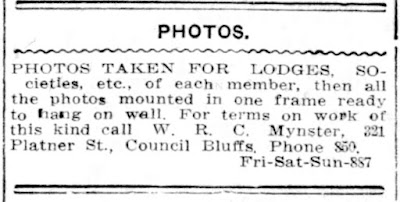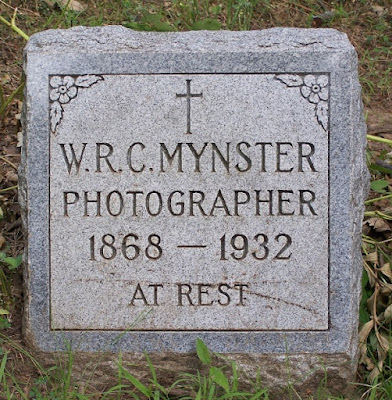It's an unexpected moment of mischief.
Maybe set off by a bad pun,
a wisecrack,
or something silly.
Maybe set off by a bad pun,
a wisecrack,
or something silly.
Instantly the jest spreads
like an electric shock.
Eyes light up,
smiles appear,
as everyone joins the fun.
like an electric shock.
Eyes light up,
smiles appear,
as everyone joins the fun.
Then in a flash
the giggles, groans,
and squeals of laughter
can not be contained.
the giggles, groans,
and squeals of laughter
can not be contained.
Clowns and comedians
understand how timing
works in humor.
understand how timing
works in humor.
And so do photographers.
This merry moment was captured in a photo postcard of 14 young ladies, members of a small orchestra. They all wear white dresses, though not identical, and are jammed together into a back corner of a stage. Other than a snare and bass drum arranged in front, all the instruments visible are strings—violins, viola, cello, and double bass.
It's a rare image of spontaneous glee. In all of my photo collection it's the only one that makes me wish I could have been there to hear the joke. The girls look around age 16 to 20 and I think they have either just performed a concert or are about to. There is no caption and the postcard was never mailed, but the photographer did helpfully leave their name stamped onto the back.
W. R. C. Mynster,
view photographer
Bell Phone Red 850
view photographer
Bell Phone Red 850
It did not take long to find W. R. C. Mynster advertising in the newspapers of Council Bluffs, Iowa.
 |
| Council Bluffs IA Evening Nonpareil 6 June 1911 |
PHOTOS OF YOUR HOME, PLACE OF
business, of the baby, of your pets, or
anything else, funerals, weddings, lawn
parties and social gatherings, a specialty.
Taken day or night. Call Bell phone Red
850. Address W. R. C. Mynster, 309 Ross
St., Council Bluffs, Ia.
business, of the baby, of your pets, or
anything else, funerals, weddings, lawn
parties and social gatherings, a specialty.
Taken day or night. Call Bell phone Red
850. Address W. R. C. Mynster, 309 Ross
St., Council Bluffs, Ia.
His full name was William Rufus Choate Mynster. Like many men named after their fathers, he chose to use his initials as his principal public name, a practice that a century later makes research a bit tricky. W. R. C. was born in Council Bluffs in 1868 and become a professional photographer after several attempts at other careers that included law, medicine, prize fighter, and gambling saloon bouncer.
His first newspaper advertisements begin in 1911 which may have been in order to compete with a growing number of photographers in his city. His specialty was in commercial photography which included taking large wide photos of convention groups, exterior scenes of buildings, and interior shots of businesses. Council Bluffs is located in Pottawattamie County in western Iowa on the east bank of the Missouri River. On the west bank is Omaha, Nebraska. In 1910 the population of Council Bluffs was 29,292 while Omaha could boast of 124,096. That's a pretty sizeable metropolitan area with a lot of potential for photographers.
{click any image to enlarge}
 |
| Panorama View of Council Bluffs, Iowa 1916, William Rufus Choate Mynster Source: Wikipedia |
Here is a panorama of Council Bluffs made by William Rufus Choate Mynster in 1916. It is described as a view of West Broadway in Council Bluffs between 1st Street on the right and the Council Bluffs Post Office and Federal Building on the left at 6th Street. This photo is in the collection of the Library of Congress.
This is a photo postcard of a beautiful house taken by W. R. C. Mynster who stamped the card with the same imprint as on the orchestra's photo. It was never mailed so the location and date is unknown, but presumably it is a home in a historic district of Council Bluffs. I just found the listing for it today, July 13, and decided it deserved to be in my collection.
 |
| Council Bluffs IA Evening Nonpareil 22 January 1915 |
PHOTOS TAKEN FOR LODGES, SO-
cieties, etc., of each member, then all
the photos mounted in one frame ready
to hang on wall. For terms of work of
this kind call W. R. C. Mynster, 321
Platner St., Council Bluffs, Phone 850.
cieties, etc., of each member, then all
the photos mounted in one frame ready
to hang on wall. For terms of work of
this kind call W. R. C. Mynster, 321
Platner St., Council Bluffs, Phone 850.
Choate Mynster, as he was also known, perhaps from his boxing days, also took photos of prisoners at the county jail and of crime scenes for the police. And every spring he would take hundreds of photos of schoolchildren. I suspect my postcard is one he took of a high school orchestra or maybe a string ensemble from a local music academy. The girls' hair styles and the quality of the photo suggest it was taken some time from 1908 to 1915.
Unlike most photographers who kept a studio for portrait work, he preferred to go to his clients. In that way he got to know many families and business people of Council Bluffs. In February 1929 the Daily Nonpareil newspaper published a superb tribute on W. R. C. Mynster's life and work as a photographer in Council Bluffs.
 |
| Council Bluffs IA Daily Nonpareil 10 February 1929 |
It is very rare to find a photo of a photographer with his camera
so I feel obliged to include it along with the full piece below.
so I feel obliged to include it along with the full piece below.
It begins:
Like the family doctor who has attended to children and children's children and even another generation to follow that, so has W. R. C. Mynster, 2128 West Broadway, photographer, said, "Look pleasant, please," to three generations of students in the local schools.
{click any image to enlarge}
 |
| Council Bluffs IA Daily Nonpareil 10 February 1929 |
The full article tells a great story of W. R. C. Mynster's life but here is an excerpt which I liked for how it described what a photographer like Mynster did for their community. It's true for many of the forgotten photographers that I have featured on this blog.
He got out among the people he intended to photograph. He was called to the bier sides of the city's departed great. He was called to cyclone areas and took pictures of the piling corpses and the wrecks of once happy homes.He met Coxey's army * as it entered the city and he photographed the flotsam and jetsam of the tides of life as they rolled their tragic way towards Washington and disillusion.He photographed the bloody evidence for the murder trial. He saw first-hand and his camera caught for all time the grotesque shapes of those who died with their boots on, the victims of hatred, passion, averice, jealousy or their own weakness.Mynster crowded into the photography business while remaining in one city, all the adventures and experiences that go to brush the moss from the rolling stone.And he photographed the children. Little ones, medium ones, grown ones, self-satisfied ones, nervous ones, pretty ones, merely cute ones, but never actually ugly ones, for, he said, "all children are beautiful to me. I love them. I like to make pretty poses of them and to catch their pictures so that their parents will always rejoice in the possession of a likeness that will last forever."He photographed the children's children and now he is photographing the third generation.
* Wikipedia: Coxey's Army was a protest march by unemployed workers from the United States, led by Ohio businessman Jacob Coxey. They marched on Washington, D.C., in 1894, the second year of a four-year economic depression that was the worst in United States history at the time. Officially named the Army of the Commonwealth in Christ, its nickname came from its leader and was more enduring. It was the first significant popular protest march on Washington, and the expression "Enough food to feed Coxey's Army" originates from this march.
On 30 June 1932, William R. C. Mynster died
after suffering a heart attack.
He was 63 years old.
after suffering a heart attack.
He was 63 years old.
What his tribute report did not mention is that W. R. C. Mynster and his wife Josephine were proud parents of ten children. Two sons: Lyonel and Edwin, and eight daughters: Cora, Sevra, Pearl, Iva, Flora, Nellie, Josephine, and Lillian.
If the photo of the orchestra was taken around 1908-1915, two daughters, Flora, born in 1893, and Nellie, born in 1894, would have been of the same age as the other girls. Did they play a musical instrument? I don't know. It's only speculation but look at the photo again. Can you spot someone who's heard the cameraman tell this joke before? That's the face that sold me on the photo and still makes me smile today.
Whether it is Flora or Nellie, or someone else, I expect W. R. C. Mynster knew a thing or two about teasing young girls to get them to show off their best features. To tell a good zinger requires a punchline given with the timing of a prizefighter, a nightclub comic, or a watchful photographer.
 |
| William Rufus Choate Mynster (1868–1932) Walnut Hill Cemetery, Council Bluffs, Iowa Source: FindaGrave.com |
This is my contribution to Sepia Saturday
where best friends always share
everything with each other.









3 comments:
Oh I'm glad you reminded me to look again to see if his daughter(s) might be among the girls in this little group. Obviously the back row with her hand to her head had heard the joke before. I'm not sure of any others though!
From his newspaper photo he just looks like a warm, pleasant fellow who could easily coax a smile and laughter from his subjects. And the article about him reinforces that idea completely. :)
Good to see such a happy group of musicians. .
Post a Comment